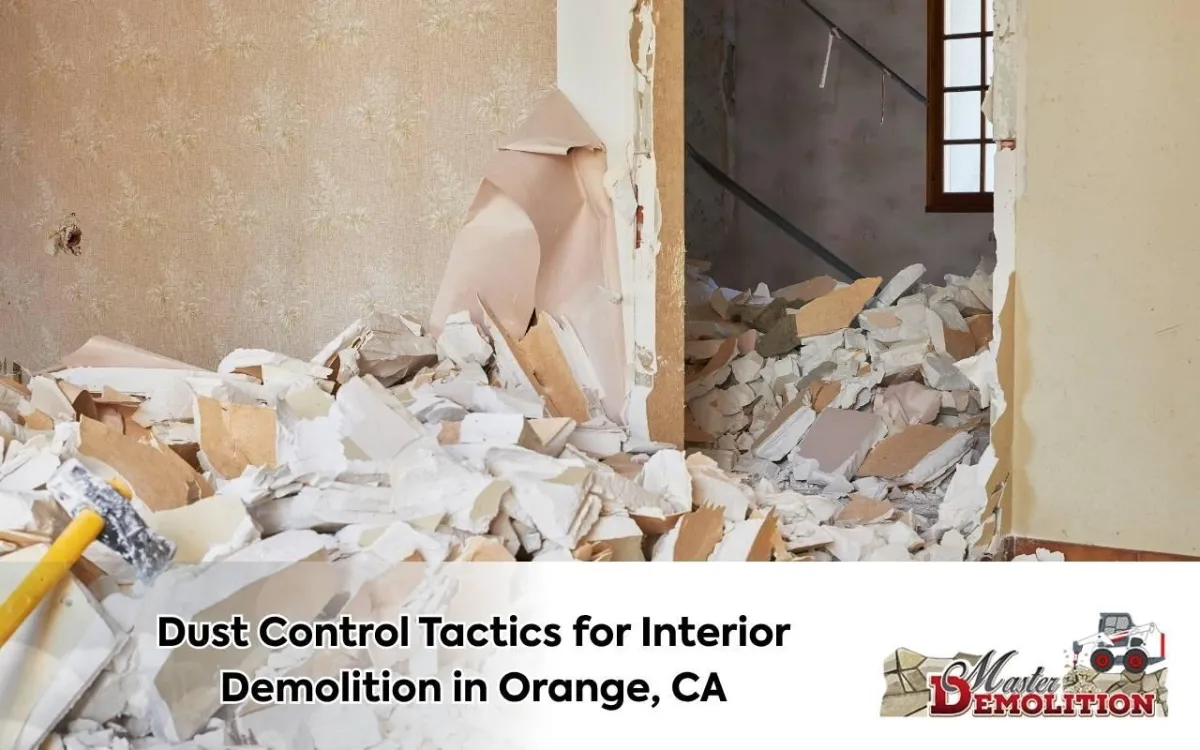
Dust Control Tactics for Interior Demolition in Orange, CA
Interior demolition transforms spaces into blank canvases ready for new purposes. Yet, dust control remains one of the greatest challenges. Dust control for interior demolition Orange CA is essential for safety and compliance with local regulations. Proper tactics protect air quality, workers, and nearby communities, ensuring projects remain smooth and professional.
Effective dust control involves sealing spaces, using HEPA filtration, setting negative air systems, and applying disciplined daily cleanups. With the right methods, contractors safeguard reputations and maintain strong client trust. For expert support, explore our demolition services in California.
Importance of Dust Control in Interior Demolition
Dust control for interior demolition Orange CA is more than a courtesy. It protects health, safety, and project efficiency. Dust particles infiltrate ventilation, sensitive equipment, and even nearby properties. Without mitigation, contractors risk delays, liabilities, and regulatory issues. Proactive dust control measures show dedication to safety, client satisfaction, and compliance.
Reduces respiratory risks for workers and neighbors.
Prevents dust from damaging machinery or equipment.
Improves compliance with air quality regulations.
Strengthens client trust and project reputation.
Sealing Techniques for Dust Containment
Sealing barriers form the first defense against dust migration. Heavy-duty plastic sheets, zippered access doors, and sealed vents contain particles. Dust control for interior demolition Orange CA depends heavily on these tactics. Contractors also secure HVAC systems to prevent contamination and check small gaps to ensure airtight control. Explore our concrete demolition solutions for related practices.
Install plastic sheeting and seal door frames.
Use zippered doors for controlled access.
Cap duct openings to protect HVAC systems.
Inspect gaps around wiring and fixtures.
Utilizing HEPA Filtration Systems
HEPA systems capture up to 99.97% of small particles. Deploying them near work zones improves visibility and air quality. Dust control for interior demolition Orange CA requires selecting proper equipment, maintaining filters, and positioning units strategically. HEPA vacuums and air scrubbers help create a safer, cleaner demolition site for crews and nearby occupants.
Regular Cleanup Procedures
Daily cleanup ensures dust remains contained. Crews sweep, vacuum, and mop surfaces to reduce build-up. Consistent cleanup prevents cross-contamination and enhances safety. Assigning cleanup crews on large projects ensures debris removal never falls behind. This discipline boosts efficiency and upholds professional standards throughout every stage of demolition.
Perform sweeps and vacuuming each shift.
Use damp mopping to trap dust.
Focus on corners and hidden areas.
Assign dedicated cleanup teams on large projects.
Implementing Negative Air Pressure Systems
Negative air systems create controlled environments during demolition. By pulling air through HEPA filters, these systems prevent dust escape. Contractors in Orange, CA rely on negative air to maintain cleaner spaces and comply with regulations. Proper calibration balances exhaust with fresh air intake, ensuring safe conditions for workers and communities.
Benefits of Using Debris Chutes
Debris chutes contain and transport waste, reducing dust release. Enclosed chutes minimize manual handling, boost safety, and accelerate material removal. For multi-story projects, modular debris chutes extend across levels. Dust control for interior demolition Orange CA benefits greatly from chutes, which limit airborne particles while improving site efficiency. Learn more about clean solutions by visiting our pool demolition page.
Safeguarding On-Site Personnel and Community
Worker protection involves PPE such as respirators, goggles, and coveralls. Regular safety meetings reinforce awareness of airborne dust risks. Contractors also protect communities by monitoring air quality and setting clear buffer zones. Transparent communication with neighbors reduces complaints and demonstrates dedication to health and professionalism.
Ensuring Compliance with Regulations
Regulations from Cal/OSHA and the EPA enforce strict dust standards. Contractors must create site-specific dust control plans that include sealing, filtration, and cleanup tactics. Documenting inspections and air readings demonstrates due diligence. Compliance reduces risks of fines, delays, and reputational damage, securing both client trust and operational success.
FAQs about Dust Control for Interior Demolition
Why is dust control important in demolition? Dust control protects health, ensures compliance, and improves project safety for crews and nearby communities.
Which tools work best for controlling dust? HEPA filtration systems, sealing barriers, and negative air units are the most effective tools.
How often should cleanup occur? Cleanup should happen daily, with sweeping, vacuuming, and wet mopping included in the routine.
Do negative air systems really help? Yes, they create controlled airflow, keeping dust inside the demolition zone and away from occupied spaces.
What role do debris chutes play? Debris chutes reduce airborne dust by containing waste during removal, especially in multi-level projects.
Mastering Dust Control for Successful Interior Demolition
Effective dust control for interior demolition Orange CA requires sealing, HEPA filtration, negative air, and disciplined cleanup. Each method safeguards health, compliance, and professionalism. By integrating these tactics, contractors minimize risks, streamline work, and build lasting client trust. For professional help, connect with us through our contact page.